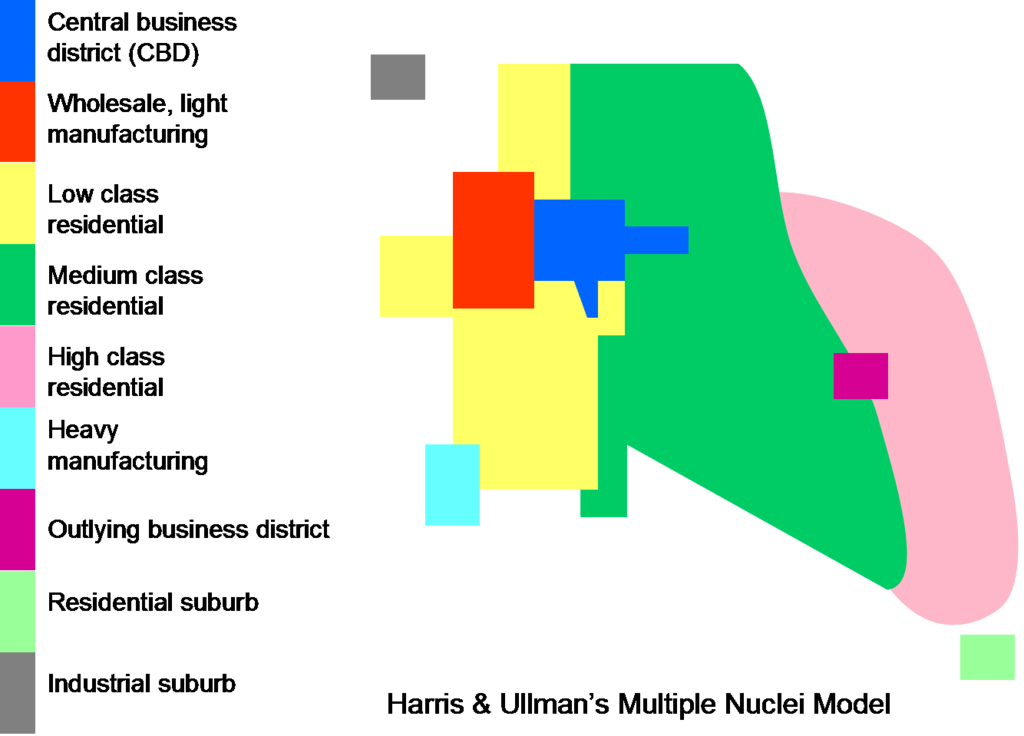It was the third model in the chicago school (architecture). Do you live in a galactic urban? Web this allows shorter commutes from the suburbs. Web this model is considered to be more suitable for cities which are large and expanding. In this model, the city is more complex and has more than one cbd.
Web the third model, called the multiple nuclei model (fig. Ullman is based on the argument that the cities have multiple growth points or “nuclei” around which growth take place. A node could exist for the downtown region, another where a university is situated, and maybe. Modern cities are more complex than suggested by other theorists.
Web the multiple nuclei model, first developed in 1945 by chauncy harris and edward ullman, proposes that urban areas are not dominated by a single central business district (cbd), but rather consist of multiple centers with different functions. Shops and offices move to the outer parts of the city. Web in the realm of urban planning, the multi nuclei theory, developed by chauncy harris and edward ullman in 1945, represents a groundbreaking departure from earlier models.
People have greater movement due to increased car ownership, allowing for the specialization of regional centers. Web the multiple nuclei model is most realistic representation of a city. The number of nuclei around which the city expands depends upon situational as well as historical factors. Web the third and final urban design is called the multiple nuclei model. Ullman is based on the argument that the cities have multiple growth points or “nuclei” around which growth take place.
This theory presents a dynamic perspective on city development, challenging the traditional notion of a single central business district (cbd). A representation of urban structure based on the idea that the functional areas of cities develop around various points rather than just one in the central business district. People have greater movement due to increased car ownership, allowing for the specialization of regional centers.
Los Angeles, With Its Many Distinct Neighborhoods, Is A Prototypical Example Of This Type Of City.
Web the multiple nuclei model is a theory in urban geography that suggests cities develop with multiple centers of activity, rather than a single central business district. A city contains more than one center around which activities revolve. This model describes the layout of a city, it is based on chicago. This latter model conceived of cities as expanding outwards from a central business district in concentric circles.
An Employer May Relocate To A Cheaper Location.
Web this allows shorter commutes from the suburbs. The is mostly true in case of large cities like mumbai, delhi, calcutta etc. For example, as city population grows, residential neighborhoods may change, and the simple monocentric structure of a city (with a single business center) is replaced with a more complex pattern. Ullman is based on the argument that the cities have multiple growth points or “nuclei” around which growth take place.
The Multiple Nuclei Model Was Developed In 1945 To Explain City Formation After The Spread Of The Automobile.
It was the third model in the chicago school (architecture). This phenomenon creates nodes or nuclei in other parts of the city other than the cbd, thus the name multiple nuclei model. Developed by geographers c.d harris and e.l ullman in 1945, the multiple nuclei model suggests that a city develops around several centers (nuclei), each serving different purposes or functions. Urban environment evolves with time.
The Number Of Nuclei Around Which The City Expands Depends Upon Situational As Well As Historical Factors.
Web it presents cities as having multiple centers or nuclei that influence development, accommodating a diversity of activities and social groups. Web the model is suitable for large, expanding cities. Web ecological models of urban form: This theory presents a dynamic perspective on city development, challenging the traditional notion of a single central business district (cbd).
This model was found to be applicable to multiple cities and not just american cities like california, new york, chicago. This theory presents a dynamic perspective on city development, challenging the traditional notion of a single central business district (cbd). Developed by geographers c.d harris and e.l ullman in 1945, the multiple nuclei model suggests that a city develops around several centers (nuclei), each serving different purposes or functions. This model was given in an article by them “the nature of cities.” Do you live in a galactic urban?



